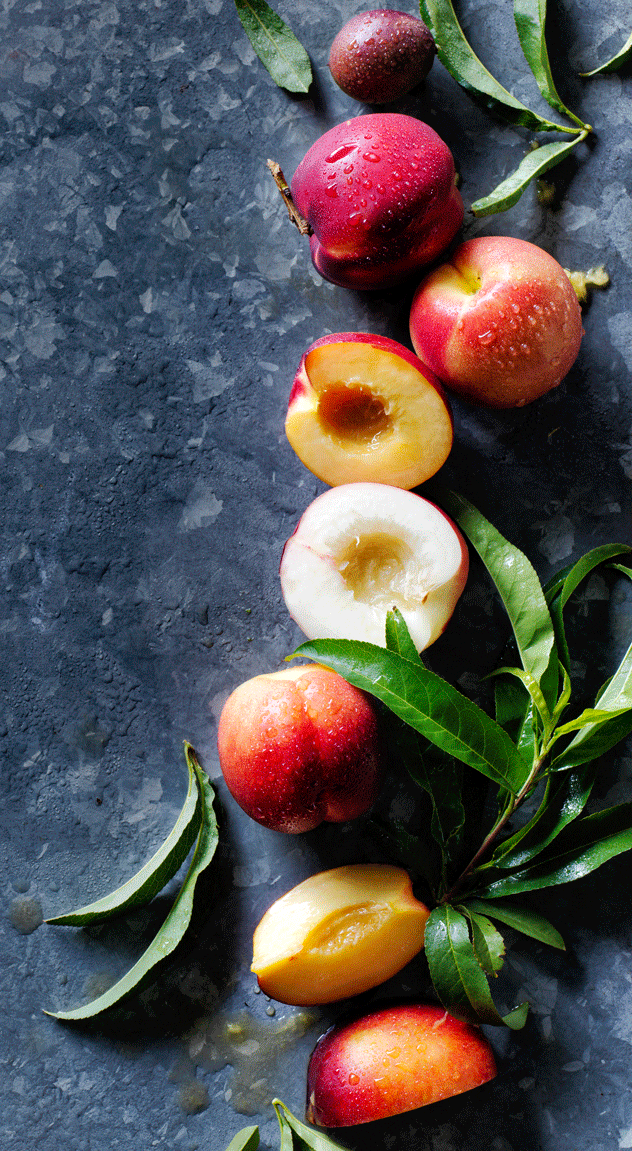The nectarine is slightly smaller than the average peach, and it has a slight rose tang. Otherwise, the two fruits are so similar that they don’t need different classifications. Like a peach, nectarine flesh is white or yellow. Likewise, the stones inside can be clingstone or freestone. Sometimes rogue nectarine seeds or stones can germinate into a peach tree, and vice versa. There are even cases of the two fruits growing on the same tree without genetically modified assistance. In fact, there is just one simple gene responsible for the main difference – the nectarine’s delicate skin. The lack of the hairy protection seen on a peach has its drawbacks, as the fruit tends to be softer and more tender, and it can bruise and suffer diseases easily. However, the thin skin makes nectarines much easier to eat – and perfect for cooking with.
NUTRITION FACTS
Nectarines are very high in vitamin C – in fact, the vitamin makes up 13 per cent of the fruit. They also contain beta carotene, which is converted into vitamin A in the body. The average nectarine has slightly fewer kilojoules than a peach, yet is still high in natural sugars compared to other fruits. The flesh is a good source of dietary fibre, and has minerals such as potassium – which is good for reducing sodium in the bloodstream. The bark, leaves and blossoms of nectarine trees are used in herbal medicine for treating ailments such as gout and rheumatism.
HOW TO GROW
Like all other stone fruits, nectarines are grown on trees. They flower early in the spring, and have a very frost- susceptible blossom. They like cold winters and hot summers, and very healthy trees will have fewer problems with leaf fungus and other airborne diseases. The trees are self-fertile, so can be grown alone without the need for a pollinating pair.
HOW TO BUY
To find ripe nectarines at the market, look for fruit that ‘gives’ slightly and has a lovely, fragrant smell. The skin of the fruit should be bold and bright, bloody red with flecks of yellow, if the skin still has a slight tint of green, the fruit has not ripened fully. This means the simple starches have not turned to sweet fructose, so the fruit will remain tart and unpalatable. As nectarines are best eaten with the skin on, locally grown organic fruit is worth looking out for.
HOW TO STORE
If the fruit is under-ripe, leave them at room temperature for 2-3 days. Try not to keep in a fruit bowl where they will touch each other – they are better spread out flat in a tray. They ripen fast in warm conditions, and mould can take over. Cover the fruit with a netted cover to stop fruit fly damage. If you’re storing nectarines in the fridge, don’t use a plastic bag. Plastic keeps the fruits pressed together and they sweat. Instead, the best option is a wooden tray covered with a baking paper and a clean tea towel. Only store in the fridge for 2-3 days at most.
REDUCE WASTE
If you’re lucky enough to have a tree, the fruit will be ready to pick when they fall away if given a simple twist. If they’re not ready, leave them on the tree – but use a net to cover to keep away pests like birds and snails. The fruit is delicate and can bruise and ripen quickly. To avoid wasting an abundance of fruit, bottling the whole nectarines (with the skin on) in large, wide-mouthed jars is a great option. Just use quickly, as they won’t keep the same flavour for long. You can also freeze the fruit in sugar syrup for a later day, to make a simple nectarine marmalade or dessert.
COOKING WITH NECTARINES
Wherever you see a peach being used in a recipe, a nectarine can quite easily be substituted – and vice versa. The main difference between the two is that the skin of the nectarine does not necessarily need to be peeled. However, nectarines are not a fruit that needs a lot of cooking. They’re delicious simply sliced and added to a rosé sangria, or placed on top of a crunchy, creamy pavlova. You can even grill them quickly then serve with some marinated chicken breasts.
COOK’S TIP
If a recipe does call for the skin of a nectarine to be removed, cut a small cross in the skin at the end of the fruit. Drop into boiling water for no longer than 15 to 20 seconds, then immediately plunge into iced cold water. The skin can then be pulled back in much the same way as peeling a tomato. Keep nectarine stones in a bag in the freezer. They’re perfect to use when making fruit jellies and jams, as they are full of pectin.




